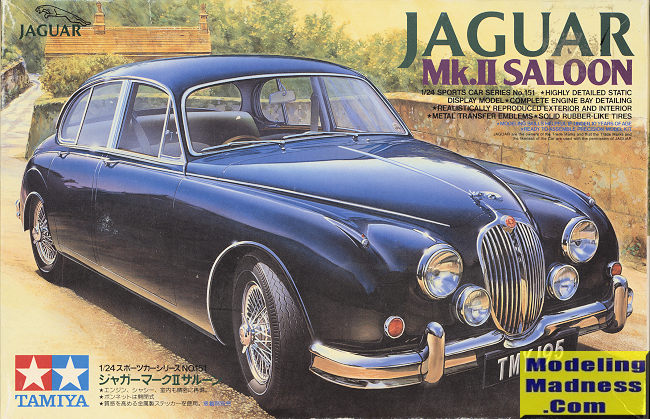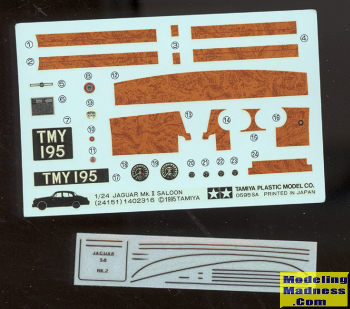
| KIT #: | 24151 |
| PRICE: | 2000 yen in 1995. I paid $25 shipped in 2017 |
| DECALS: | One option |
| REVIEWER: | Scott Van Aken |
| NOTES: | 1995 tooling |

| HISTORY |
The Jaguar Mark 2 is a medium-sized saloon car built from late 1959 to 1967 by Jaguar in Coventry, England. Twelve months before the announcement of the XJ6 the 2.4 Litre and 3.4 Litre Mark 2 models were renamed to Jaguar 240 and Jaguar 340 respectively. The previous Jaguar 2.4 Litre and 3.4 Litre models made between 1955 and 1959 have been identified as Mark 1 Jaguars since Jaguar produced this Mark 2 model.
Until the XJ, Jaguar's postwar saloons were usually denoted by Roman numerals (e.g. Mark VII, Mark VIII) while the Mark 2 used Arabic Numerals, denoted on the rear of the car as "MK 2".
Adhering to Sir William Lyons' maxim of "grace, pace and space", the Mark 2 was a fast and capable saloon. It came with a 120 bhp (89 kW; 120 PS) 2,483 cubic centimetres (152 cu in), 210 bhp (160 kW; 210 PS) 3,442 cubic centimetres (210 cu in) or 220 bhp (160 kW; 220 PS) 3,781 cubic centimetres (231 cu in) Jaguar XK engine. The 3.8 is similar to the unit used in the 3.8 E-Type (called XKE in the USA), having the same block, crank, connecting rods and pistons but different inlet manifold and carburation (two SUs versus three on the E-Type in Europe) and therefore 30 bhp (22 kW) less. The head of the six-cylinder engine in the Mark 2 had curved ports compared to the straight ports of the E-Type configuration. The 3.4 Litre and 3.8 Litre cars were fitted with twin SU HD6 carburettors and the 2.4 Litre with twin Solex carburettors.
Some explanation is required concerning the claimed bhp figures shown above. Jaguar used gross bhp figures throughout the production period of the Mk II and 240/340 models. A direct conversion into DIN bhp is not possible, but we know that the 3.8 Mk II engine developed around 190 bhp DIN. This compares with the later 4.2 XJ6 engine which also gave around 190 bhp DIN or 245 gross bhp, according to Jaguar, both being for 8:1 compression engines. The explanation was that the lower peak for the XJ6 4.2 engine meant that the bhp was being delivered at less rpm, for the same output. The camshaft timing and inlet and exhaust valve sizes were the same for the 2.4,3.4,3.8 Mk II and XJ6 4.2 engines, so the engines throttled themselves sooner in the bigger engine sizes. The later 4.2 XJ6 engines had special induction pipes, to reduce exhaust emissions, that crossed over between the inlet and exhaust sides of the engine, which reduced bhp to around 170 bhp on later production.
Compared to the Mark 1, appearance of the car was transformed by an increase of 18% in cabin glass area greatly improving vision. The car was re-engineered above the waistline, slender front pillars allowed a wider windscreen and the rear window almost wrapped around to the enlarged side windows now with the familiar Jaguar D-shape above the back door and fully chromed frames for all the side windows. The radiator grille was amended and larger side, tail and fog lamps repositioned. Inside a new heating system was fitted and ducted to the rear compartment (although still notoriously ineffective). There was an improved instrument layout that became standard for all Jaguar cars until the XJ series II of 1973.
The front suspension geometry was rearranged to raise the roll centre and the rear track widened. Four-wheel disc brakes were now standard. Power steering, overdrive or automatic transmissions could be fitted at extra cost. The 3.8 Litre was supplied fitted with a limited-slip differential.
The Mark II was over 100 kg heavier than the 2.4 / 3.4 cars. Almost 84,000 Mark II cars were built between 1959 and 1967.
| THE KIT |
Most of you are aware that pretty much anything Tamiya does, they do well. This is true of their car kits as much as anything else and this one is no exception. One often wonders why they do some of the subjects that end up as kits, but I for one am pleased to have found that they do this one.
I got this 1995 release via the 'used kit' market with all the bits still in their plastic bags. The box had been around, but then we don't build the box. This is not a curbside and so comes with a very nice representation of the Jaguar DOHC straight six, an engine that was very reliable and powered many Jaguar sedans and sports cars for decades. The first three of seventeen construction steps concentrates on the engine.
Once installed in the floor pan, the exhaust and chassis components are attached. Disc brakes and a trailing arm rear suspension are provided along with a standard wishbone front end. Polycaps are hidden in each of the brake assemblies to hold the wheels.
After installing the firewall and wheels, one does the carpeting. A section of maroon felt and a template are provided so you can cut out the sections and install them on the floor. Then one installs the dash (right hand drive, of course) along with the door interior pieces and the seats. Note that wood grain decals are provided for the doors and other portions of the car that will get these.
 By this
time, you will have a full chassis and interior so can install the wheels. The
glass parts are installed from the inside so it would be advised to paint the
exterior body prior to this. All the edges of the clear bits are chrome so
you'll need to do a bit of masking before gluing in the windows. If you look
below the decal sheet, you will see embossed decals for the exterior chrome
trim. This needs to be installed prior to adding the fiddly bits. These are best
installed after the body has been mated to the chassis, if for no other reason
than there are rear wheel skirts that have to be fitted.
By this
time, you will have a full chassis and interior so can install the wheels. The
glass parts are installed from the inside so it would be advised to paint the
exterior body prior to this. All the edges of the clear bits are chrome so
you'll need to do a bit of masking before gluing in the windows. If you look
below the decal sheet, you will see embossed decals for the exterior chrome
trim. This needs to be installed prior to adding the fiddly bits. These are best
installed after the body has been mated to the chassis, if for no other reason
than there are rear wheel skirts that have to be fitted.
Instructions are excellent and, as you'd expect, provide Tamiya paint references. There are six different exterior colors provided with three of them matching Tamiya rattle can colors. The other three will need to be mixed as will the interior colors, which are two shades of red. Decals are nicely done and while a bit old, I doubt if there will be issues applying them as long as one uses fairly hot water.
| CONCLUSIONS |
This is a kit I've had on my 'want' list for a while and though not actively searching for it, when one became available at a good price, I did not hesitate to pick it up. If you have an interest in similar cars, you might also want to consider it.
| REFERENCES |
https://en.wikipedia.org/wiki/Jaguar_Mark_2
January 2018
Copyright ModelingMadness.com. All rights reserved.
Thanks to
for the review kit. You can find this kit at your favorite hobby shop or on-line
retailer. If you would like your product reviewed fairly and
fairly quickly, please
contact
the editor or see other details in the
Note to
Contributors. Back to the Main Page
Back to the Review
Index Page
Back to the Previews Index Page